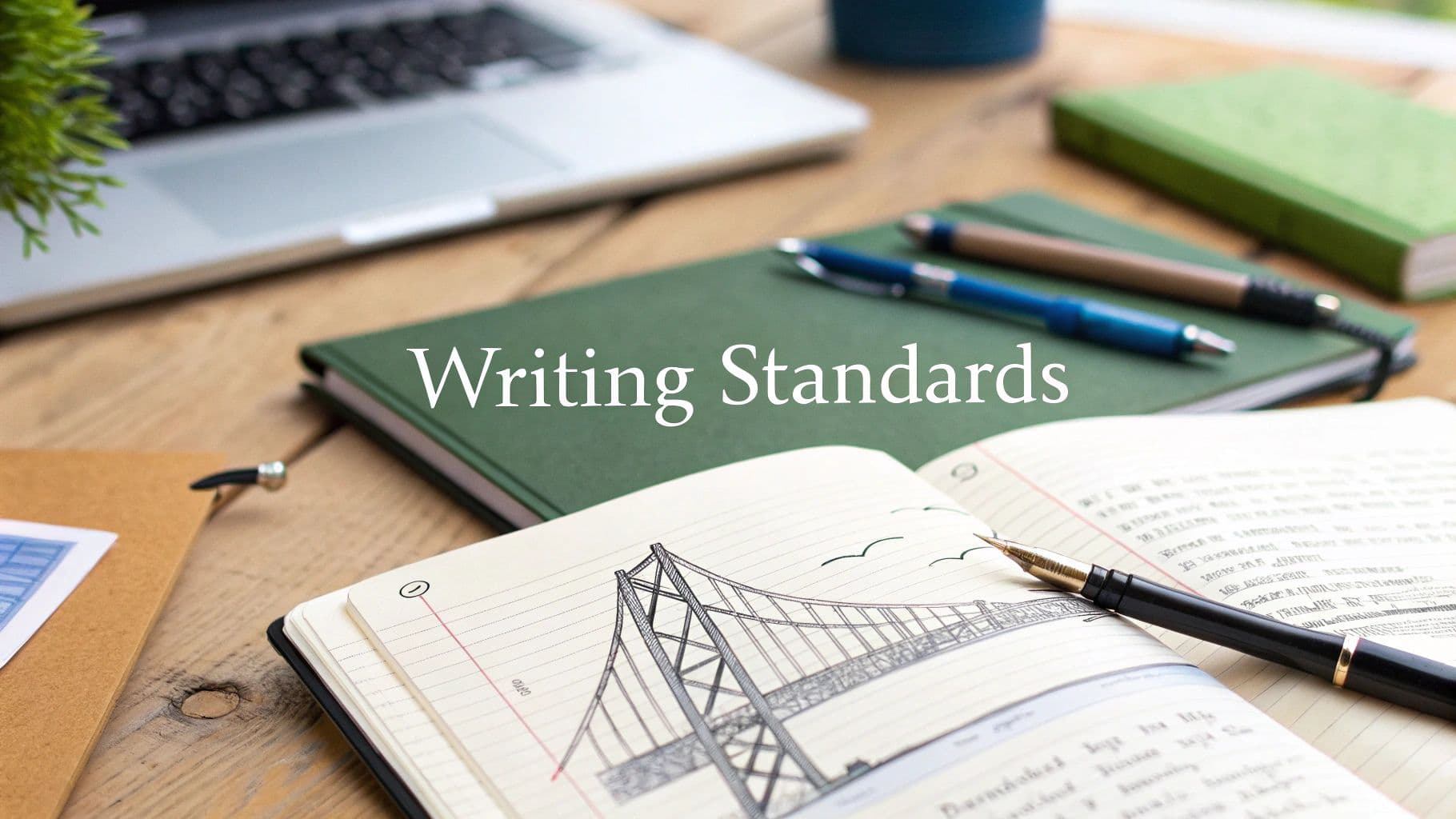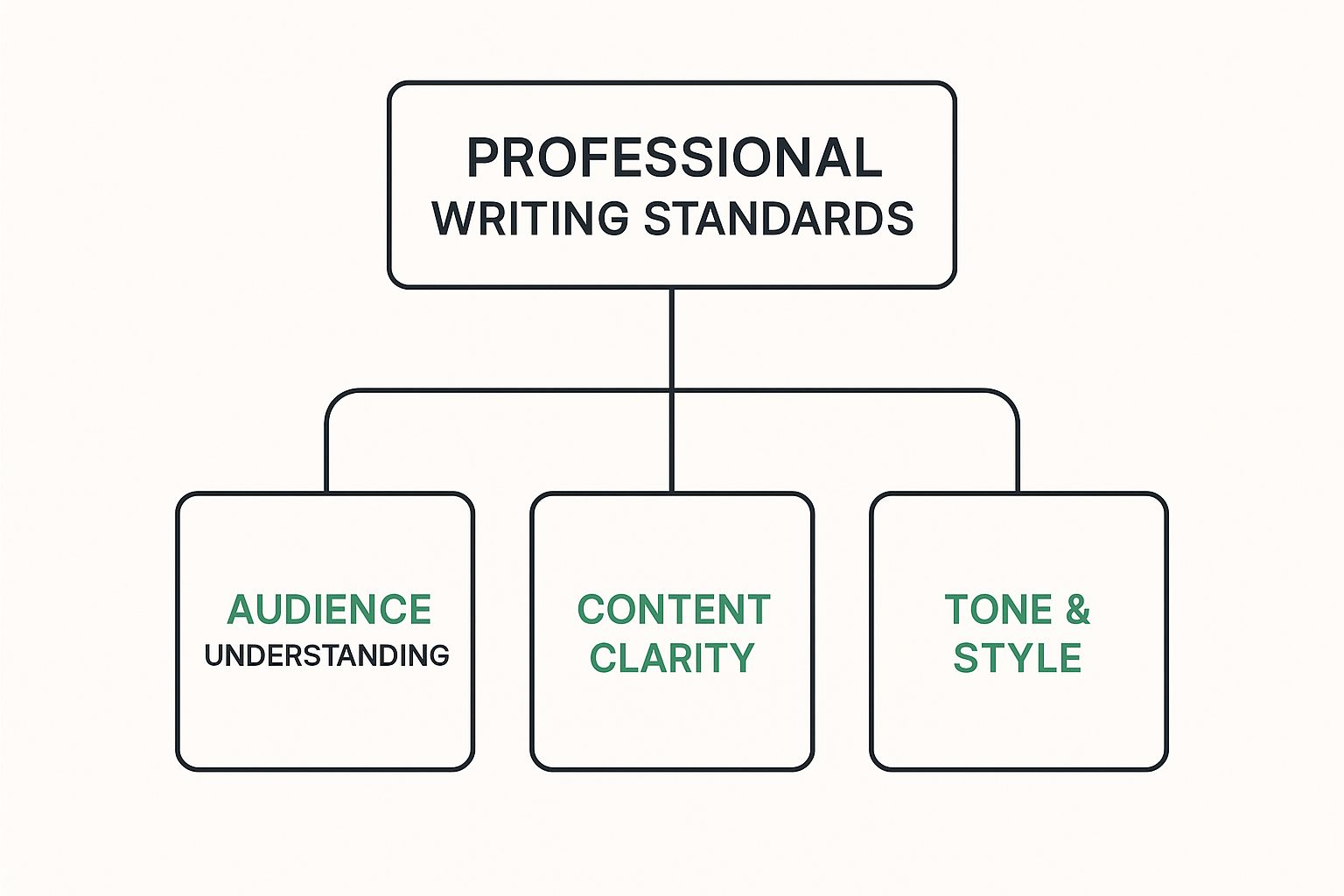
Mastering Professional Writing Standards Today
June 28, 2025
Professional writing standards are the unspoken rules that separate clear, impactful communication from the kind of writing that gets ignored. This isn't just about good grammar or spelling. It's about a complete framework for building trust, shaping decisions, and getting your ideas across with authority.
Think of it as the difference between a flimsy shack and a well-built house. Both provide shelter, but only one is built to last.
Why Professional Writing Standards Matter
Imagine trying to build a sturdy bridge with a team of engineers but no blueprint. You might have the best materials and the smartest people, but without a shared plan for clarity, strength, and purpose, the final structure would be a mess. It would be unreliable and, frankly, dangerous.
Your writing works the same way. Professional writing standards are your blueprint. They ensure every email, report, or presentation you create is solid, clear, and actually does what you need it to do.
This isn't some new-age business trend. The need for clear, standardized communication is as old as civilization itself. The earliest forms of writing, dating back to around 3200 BC, were created for a very practical reason: record-keeping. Over the centuries, these simple pictographs evolved into complex phonetic alphabets, allowing for far more precise and universal expression. This long journey from basic accounting to sophisticated language laid the groundwork for the standards we rely on today. For those interested, you can explore more on how early writing systems paved the way for modern communication standards.
The Core of Professional Communication
At its heart, professional writing is about accomplishing a specific goal with a specific audience in mind. It doesn't matter if you're trying to persuade a hesitant client, update your team on a project's progress, or ask for a budget increase. Your success hinges entirely on how well your message lands.
This chart breaks down the foundational elements that support all great professional writing.

As you can see, everything flows from the audience. A deep understanding of who you're writing for determines how you structure your content for clarity and what kind of tone and style will be most effective.
Sticking to professional writing standards isn't about being stuffy or rigid; it's about being effective. It's the most reliable path to making sure your ideas are understood, respected, and—most importantly—acted upon.
Mastering these standards elevates your writing from a simple daily task to your most powerful professional tool. It helps you:
- Build Credibility: Clean, well-organized writing instantly signals that you're competent and pay attention to detail.
- Prevent Misunderstandings: Clarity leaves no room for the kind of ambiguity that leads to costly errors or awkward conversations.
- Increase Your Influence: When you write with your audience in mind, your words can sway opinions and drive real decisions.
- Advance Your Career: Year after year, strong communication skills are ranked among the top qualities employers hunt for.
The Four Pillars of Professional Writing
To make these concepts even more concrete, we can break them down into four core pillars. Think of these as the non-negotiable foundations for any piece of professional writing.
| Pillar | Description | Why It Matters |
|---|---|---|
| Clarity | The message is simple, direct, and easy to understand. It avoids jargon and ambiguity. | Ensures your reader gets the point quickly without confusion, which prevents mistakes and saves time. |
| Conciseness | Every word serves a purpose. It gets straight to the point without filler or fluff. | Respects the reader's time and attention. A tight message is a powerful message. |
| Audience Awareness | The tone, style, and content are tailored to the reader's needs, knowledge, and expectations. | Makes your message relevant and persuasive. It shows you've done your homework and value the reader. |
| Professionalism | The writing is polished, error-free, and follows established formatting conventions. | Builds credibility and trust. It demonstrates competence and a high standard of work. |
Ultimately, these standards aren't just a list of rules to follow. They are about using language with intent and purpose. When you get this right, you transform your words from mere text on a screen into a tool that builds relationships, conveys true expertise, and achieves real results in any professional setting.
How Modern Writing Standards Came to Be

The professional writing standards we follow today didn't just appear out of thin air. They’re the hard-won result of centuries of trial and error, forged by a real-world demand for greater clarity, precision, and critical thought. Once you understand this history, you realize these aren't just arbitrary rules—they're battle-tested solutions to complex communication problems.
This evolution really kicked into gear during the 18th and 19th centuries, thanks to a major shift in higher education. Universities started moving away from just consuming classical knowledge and began focusing on producing new research. This new purpose demanded a much more rigorous approach to writing.
This educational pivot was critical. Scottish and English universities began offering practical writing instruction to equip more students for public and intellectual life. By the 19th century, this model was refined in German universities, which pioneered the research seminars and papers that demanded exceptional rigor. You can learn more about how writing evolved through history to meet these new academic and professional needs.
From Academia to Industry
As the Industrial Revolution took off, these academic principles of clarity and structure started bleeding into the business and technical worlds. Suddenly, precision wasn't just for scholarly articles; it was essential for safely operating new machinery and managing complex, growing companies.
Then the 20th century came along and accelerated everything. Two world wars and the Cold War spurred massive technological breakthroughs, and the stakes for clear communication shot through the roof.
A poorly written manual for a piece of military hardware or an ambiguous engineering spec could have catastrophic consequences. This immense pressure forged a new, uncompromising emphasis on absolute clarity and precision in all professional communication.
This period cemented the core principles of modern professional writing we still rely on:
- Unambiguous Language: Instructions and reports had to be impossible to misinterpret. There was no room for error.
- Logical Structure: Information needed to be organized so people could find what they needed quickly and reliably, often under pressure.
- Audience-Centric Focus: Manuals weren't written for the engineers who designed the equipment. They were written for the soldiers and technicians who had to use and fix it in the field.
The Rise of Digital Communication
The personal computer boom and the dawn of the internet sparked yet another seismic shift. With information suddenly available instantly, conciseness and scannability became king. Readers weren't just reading; they were skimming, searching, and clicking.
Today’s professional writing standards are a direct reflection of this entire history. They blend academic rigor with technical precision and digital-age brevity, creating a framework designed for maximum impact in our fast-paced world.
Crafting a Professional Style and Tone

With the basics out of the way, let’s get into the more practical art of shaping your writing’s voice. Developing a professional style isn't about sounding like a robot or burying your message in formal language. It’s about projecting authority and confidence through sheer clarity.
Think of your writing tone as its personality. Just like you'd shift your speaking voice between a casual team meeting and a formal client presentation, your writing needs to adapt. The trick is to find that sweet spot between being approachable and authoritative, making sure your message lands exactly the way you want it to.
Embrace the Power of Active Voice
One of the fastest ways to elevate your writing is to use the active voice. It’s simple: the subject of the sentence does the action. This makes your writing direct, energetic, and incredibly clear. On the other hand, the passive voice often makes sentences clunky and weak, leaving the reader wondering who’s actually doing what.
Look at how a simple switch transforms a sentence:
- Passive (Weak): The report was completed by the marketing team. (10 words)
- Active (Strong): The marketing team completed the report. (6 words)
The active version is not only 40% shorter but feels more confident and is just plain easier to read. It cuts through the fog and gives your writing a forward momentum that keeps busy readers engaged.
Switching to the active voice is more than just a grammar fix. It’s a strategic move. It makes your writing more assertive, accountable, and impactful, signaling that you’re in complete command of your topic.
Eliminate Jargon and Prioritize Clarity
Confusing jargon is the enemy of good communication. Sure, industry-specific terms have their place when you’re talking to other experts, but they create an instant barrier for anyone else. True professionalism isn’t about showing off with big words; it’s about having the skill to explain complex ideas in simple, accessible language.
Before you hit send on that email or publish that report, just ask yourself: "Would someone outside my department get this?" If there's any doubt, find a simpler way to say it. For a deeper dive on this and other hands-on techniques, check out our guide on effective writing strategies you can start using today.
Ensure Consistency in Language and Formatting
Finally, consistency is one of those quiet but powerful signs of professionalism. It shows you’re meticulous and that you respect your reader's time and attention. This applies to every single part of your document, from the words you choose to the layout.
Here’s where you need to be consistent:
- Terminology: If you call it a "user dashboard" in the first paragraph, don't call it a "client portal" on the next page. Stick with one term.
- Formatting: Use the same font styles, heading sizes, and bullet point formats from beginning to end.
- Tone: Maintain the same voice—whether it's formal, instructional, or persuasive—throughout the entire piece.
This kind of uniformity doesn't just make your work look professional. It makes your content far easier for your audience to read and understand, building your credibility with every word.
Structuring Your Documents for Impact
A powerful message can easily get lost in a sea of disorganization. Even the most brilliant idea will fail to land if it’s presented as a dense, confusing wall of text. Good document structure isn’t about making things look neat—it's about building a clear, logical path for your reader to follow, guiding them effortlessly from your first point to your final conclusion.
Think of yourself as an architect. Your job is to design a structure that’s both functional and easy to navigate. In writing, this means using headings, paragraphs, and lists to create a "roadmap" that keeps your reader from getting lost. Well-structured writing respects your reader's time and makes your key points impossible to miss.
The Inverted Pyramid Principle
One of the most effective frameworks in professional writing is the Pyramid Principle, often called the inverted pyramid. This approach flips traditional storytelling on its head. Instead of building up to a big reveal, you start with it. State your most important finding or key message right up front, in the very first sentence or paragraph.
From there, you progressively add layers of supporting detail:
- Start with the Answer: Give the main conclusion or recommendation first.
- Summarize Key Arguments: Group and summarize the reasons that support your conclusion.
- Provide Supporting Data: Offer the specific facts, evidence, and data for each argument in a logical order.
This "conclusion-first" method is incredibly effective in a business setting because it gets straight to the point. Busy executives and colleagues can grasp your core message in seconds and then decide if they need to dig deeper for more detail.
Choosing the Right Structure
Not every document needs the same architecture. A quick status update has a different flow than a deep-dive research report. Choosing the right structure depends entirely on what you're trying to achieve and who you're writing for.
Here’s a quick comparison of common structures and where they work best:
Document Structure Comparison
| Document Type | Recommended Structure | Key Benefit |
|---|---|---|
| Executive Summary | Inverted Pyramid | Delivers the most critical information immediately for time-poor readers. |
| Research Report | IMRaD (Intro, Methods, Results, Discussion) | Provides a systematic, universally understood format for presenting findings. |
| Project Proposal | Problem-Solution-Benefit | Frames the project around a clear need and persuades by showing value. |
| Instructional Guide | Chronological / Step-by-Step | Guides the reader through a process in a logical, easy-to-follow sequence. |
Matching your structure to your document's purpose is a simple but powerful way to improve its clarity and impact.
Using Headings and Lists Effectively
Beyond the big-picture framework, it's the small structural elements that truly make a difference in readability. Your headings and subheadings act as signposts, breaking up long sections and letting readers scan for the information that matters most to them. They should be clear, descriptive, and create an obvious hierarchy.
Similarly, use bulleted or numbered lists to make complex information more digestible. Lists are perfect for breaking down steps, outlining benefits, or highlighting key takeaways that might otherwise get buried in a paragraph. For more hands-on guidance, exploring business writing skills training can provide structured learning on how to implement these techniques.
A well-structured document doesn’t just present information; it anticipates the reader’s questions and answers them in a logical sequence. It’s a fundamental aspect of professional writing standards that demonstrates clarity of thought and respect for your audience.
Ultimately, mastering document structure is about controlling the flow of information. When you build a clear, scannable, and logical framework, you ensure your message is not only received but also understood and remembered. That's how you maximize your impact every single time.
Adapting Your Writing for Different Fields

Professional writing is not a "one size fits all" skill. While the bedrock principles like clarity and conciseness always matter, how you apply them changes dramatically depending on your industry and audience. True mastery means knowing how to shift your style, tone, and structure to fit the context you're in.
Think of it like being a good chef. You wouldn't use the same delicate spices for a hearty beef stew that you would for a light, airy dessert. In the same way, the language you use in a persuasive marketing proposal is worlds away from the ironclad precision needed in a legal contract. One is built to inspire action, the other to eliminate all ambiguity.
True expertise isn't about blindly following rules. It’s about making strategic choices based on who you're writing for and what you want to achieve. The goal is to create writing that's not just correct, but perfectly suited for its purpose.
This adaptability is what separates good writers from great ones. It's about moving from simply following a template to making smart decisions that make your work more effective in any field.
The Specialized Demands of Technical Writing
Nowhere is this need for adaptation clearer than in technical writing. This field didn't just appear out of nowhere; it grew from a critical need to make complex things understandable for people who aren't experts. Here, the standards are all about absolute clarity, accuracy, and ease of use.
The profession’s modern roots go back to the early 20th century, especially around World War I, when new technologies in aerospace and medicine required flawless documentation to ensure safety. Later, the invention of the transistor in 1947 and the computer revolution created a massive demand for writers who could explain how to use increasingly complex devices. It all led to technical writing being formally recognized as a profession by the U.S. Department of Justice in 1980, solidifying its unique standards. You can discover more about the history of technical writing to see just how deep its roots go.
Contrasting Writing Styles Across Industries
To really see this in action, let's compare the demands of a few different fields. Each has its own set of professional writing standards, shaped entirely by its unique goals and what its audience expects.
Here’s a quick look at how the focus shifts:
- Marketing Copy: The main goal here is persuasion. The writing has to be benefit-driven, connect on an emotional level, and create a sense of urgency. Clarity is important, but getting someone to take action—like making a purchase—is how you measure success.
- Academic Writing: This is all about contributing to a scholarly conversation. The standards demand strict citation, an objective tone, and a logical structure that presents a strong, evidence-backed argument.
- Legal Writing: Precision is everything. Every single word is chosen to be completely unambiguous because the document could face legal challenges. The writing is formal, highly structured, and follows rigid formatting rules.
Once you understand these nuances, you can start tailoring your approach for maximum impact. For more hands-on advice, you can find a ton of professional writing tips in our other guide.
Of course. Here is the rewritten section, designed to match the expert, natural, and human-like style of the provided examples.
Your Questions About Professional Writing, Answered
Even when you get the basics of professional writing down, new questions always pop up. It's one thing to know you need to be clear and concise, but it's another to apply that in a tricky, real-world situation.
Let's tackle some of the most common hurdles writers run into. Think of this as a quick-reference guide to clear up confusion and give you some practical advice you can start using right away.
How Can I Get Better at This, Fast?
Improving any skill takes time, but you can definitely speed up the process by focusing on a few high-impact habits. The trick isn't to master everything at once. It's to nail down a couple of fundamentals that deliver big results.
It's a lot like learning an instrument. You don't start by playing a complex symphony; you master the scales first.
- Read your work out loud. This is the single best way to catch awkward phrases, run-on sentences, and a clunky tone. If it sounds weird when you say it, it's going to feel weird when they read it.
- Use a digital writing coach. Tools like the Hemingway App are brilliant for spotting things like passive voice or sentences that are just too complicated. Think of it as a diagnostic tool that flags where you can simplify.
- Get a second opinion. Before you hit send on an important email or document, ask a colleague you trust to give it a quick scan. A fresh pair of eyes will see the problems you've become blind to.
Stick with these three habits, and you'll see your skills sharpen faster than you'd expect.
Do I Write Emails and Reports the Same Way?
No, not at all. While the core principles—like clarity—are the same everywhere, the way you apply them has to change with the format. What someone expects from a quick email is completely different from what they expect in a formal report.
The key is to match your writing style to the medium. An email that reads like a formal report will probably get ignored, and a report that’s as casual as an email just won’t feel credible.
Emails, for example, demand brevity. You should get to your point or your "ask" within the first sentence or two. Reports, on the other hand, need structure. They need clear headings, an introduction, supporting evidence, and a solid conclusion. The tone of a report is usually objective and data-driven, while an email can be more conversational—depending on who you're writing to, of course.
What Are the Biggest Writing Mistakes to Avoid?
Even the most seasoned pros can fall into bad habits. Just knowing what the common pitfalls are is the first step to dodging them and keeping your writing sharp.
Here are the top five mistakes that can really hurt your credibility:
- Unexplained Jargon: Leaning on industry acronyms and buzzwords is a great way to alienate anyone not in your immediate circle. It just creates confusion.
- Too Much Passive Voice: This makes your writing sound weak and indirect. "Mistakes were made" is a classic example. It’s far less powerful than saying, "Our team made a mistake."
- Ignoring Structure: Big, dense paragraphs without any headings or lists are a nightmare to read. You're forcing your reader to work way too hard just to find your point.
- Skipping Proofreading: A single typo can be enough to signal a lack of care. It’s a small thing that can do big damage to your professional image.
- Forgetting the Audience: This is the big one. Writing what you want to say instead of what your reader needs to hear. Always frame your message around their perspective and what matters to them.
How Is AI Changing the Rules for Professional Writing?
AI writing tools are best thought of as powerful assistants, not replacements for skilled writers. They’re changing how we work, but they aren't changing the fundamental standards of what makes writing good. The new skill is learning how to use AI for efficiency while applying your own human judgment for strategy and nuance.
AI is fantastic for grunt work—checking grammar, suggesting ways to be more concise, or even brainstorming a few ideas to get you started.
But a human is still essential for the high-level thinking that defines truly professional work. That means making sure the tone is right for your audience, the message is persuasive, the information is factually correct, and the final piece actually sounds like you or your brand.
Ready to ensure your writing is always clear, professional, and ready for your audience? Natural Write can help. Our platform refines AI-generated text or your own drafts into natural, human-like language, helping you meet the highest professional writing standards with a single click. Elevate your emails, reports, and marketing copy by visiting https://naturalwrite.com to try it for free.


